
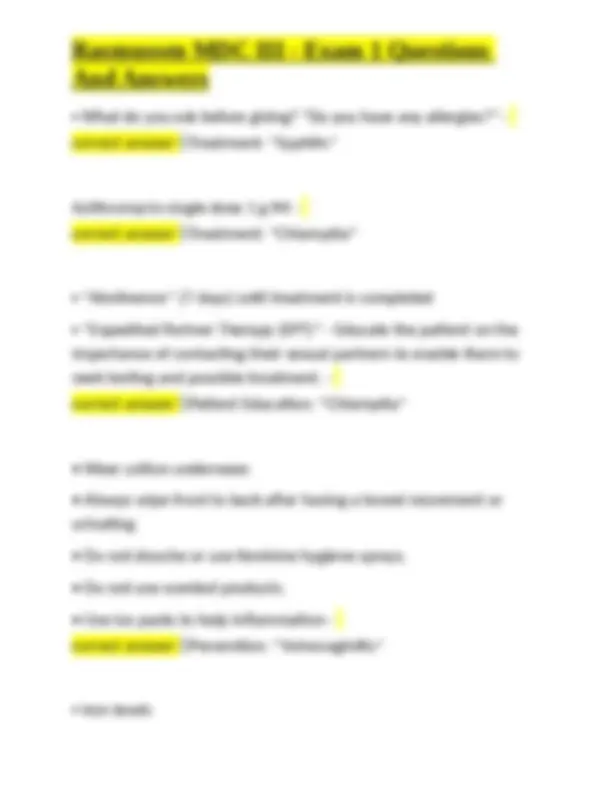
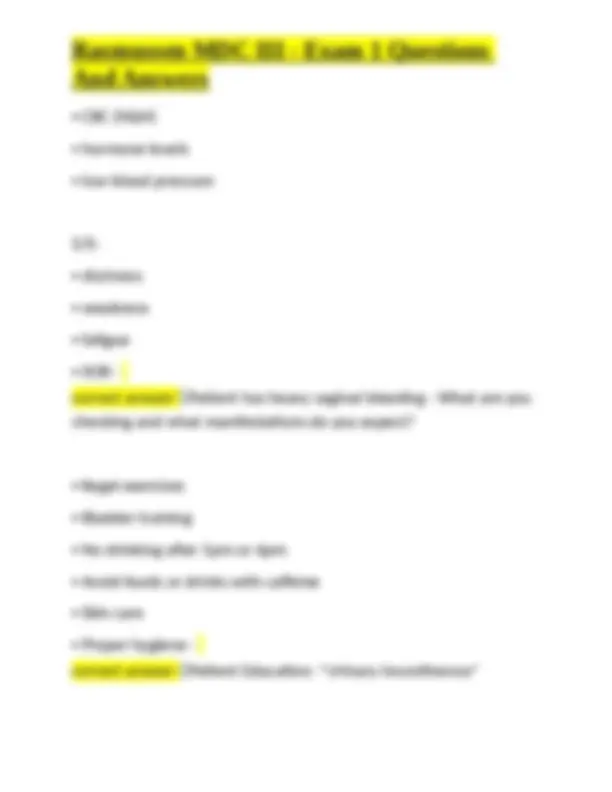
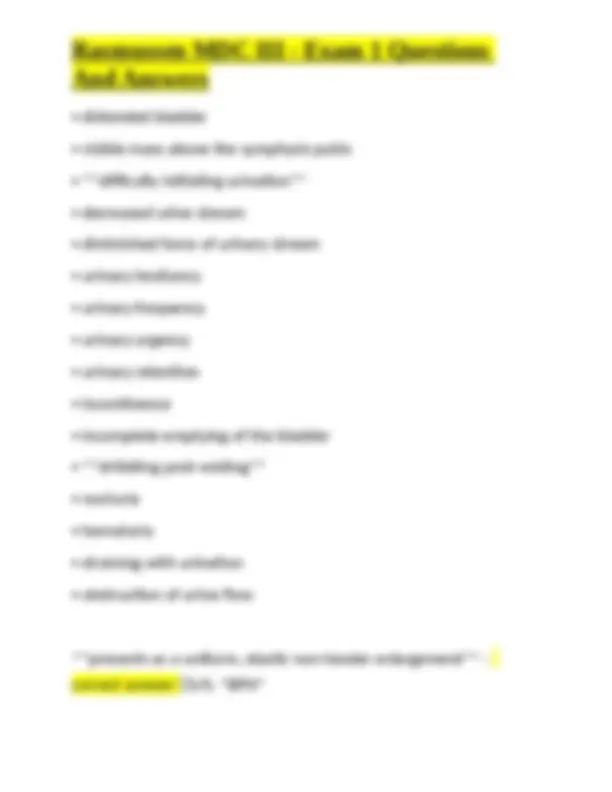
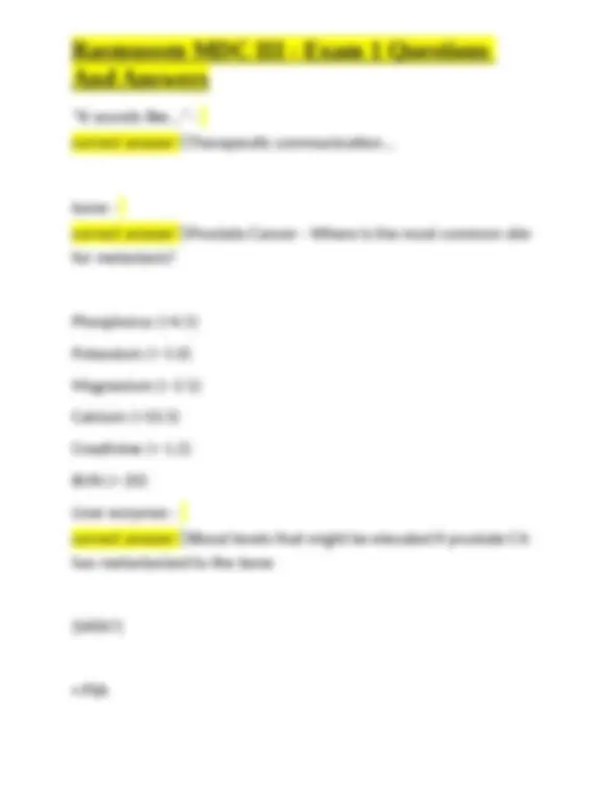

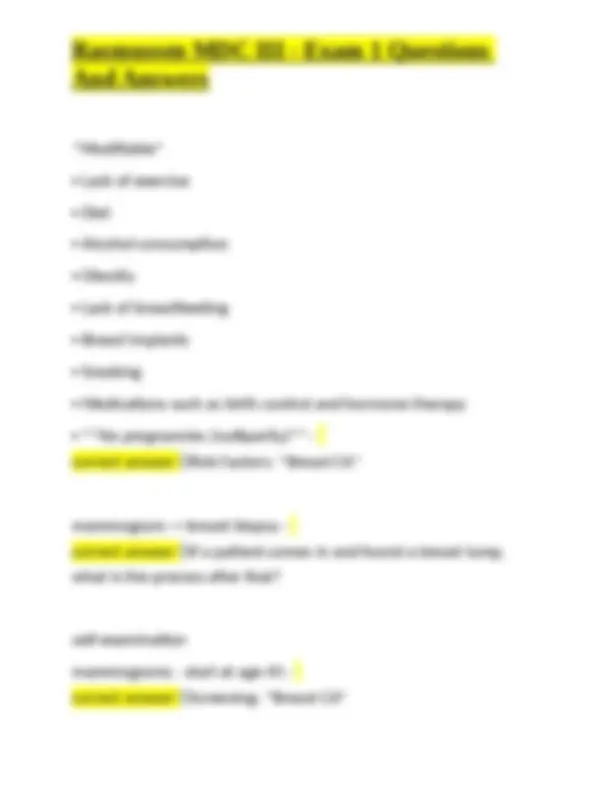
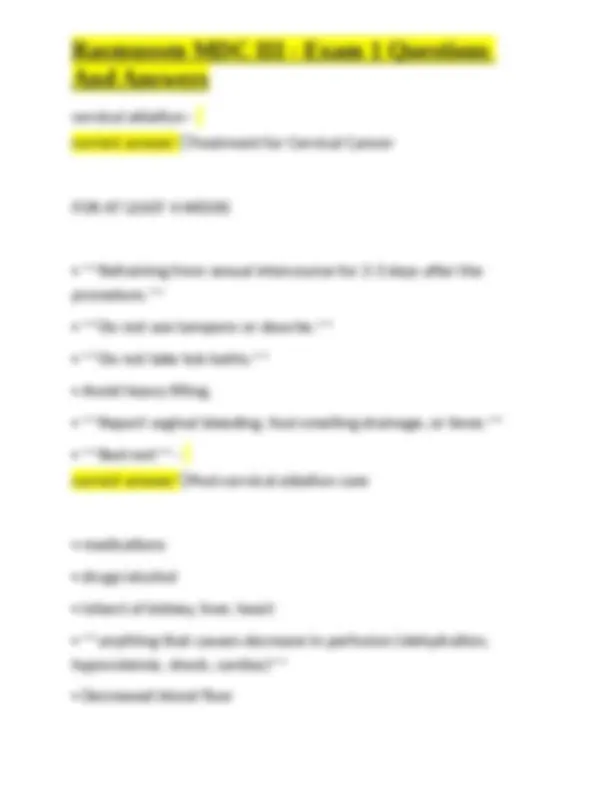
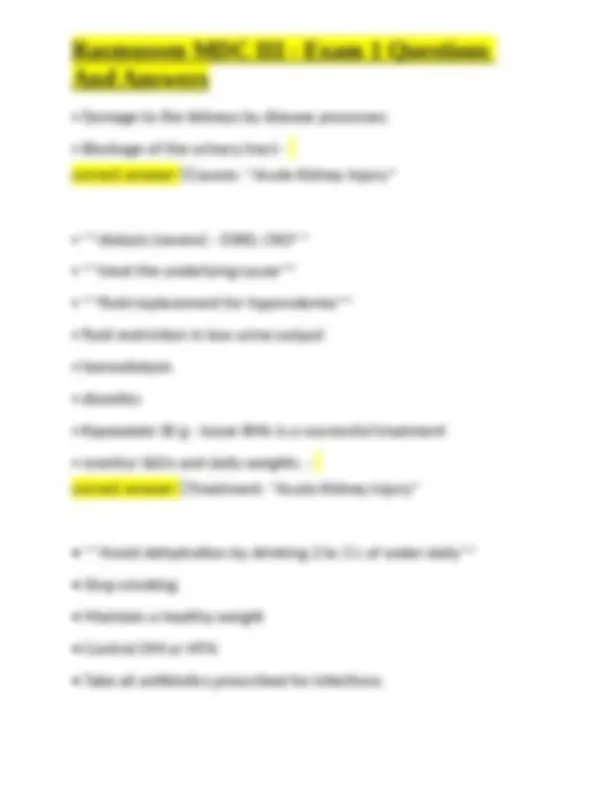
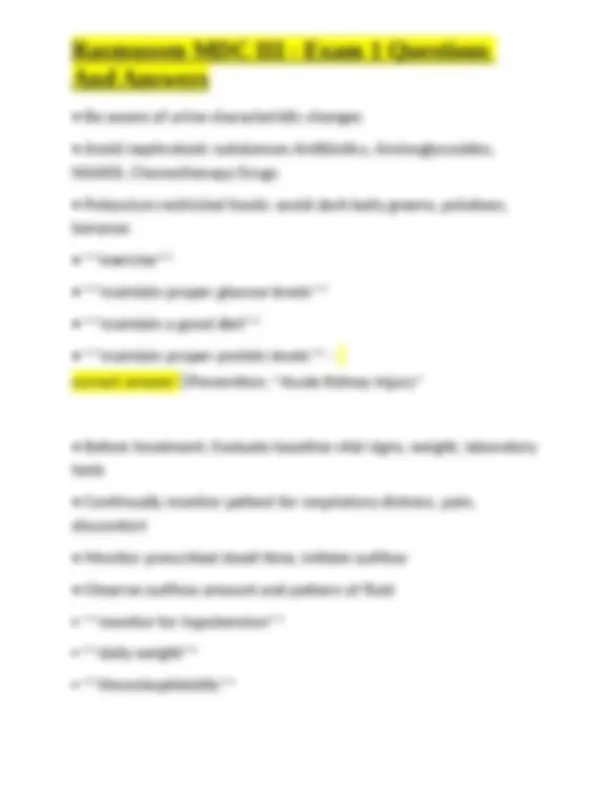
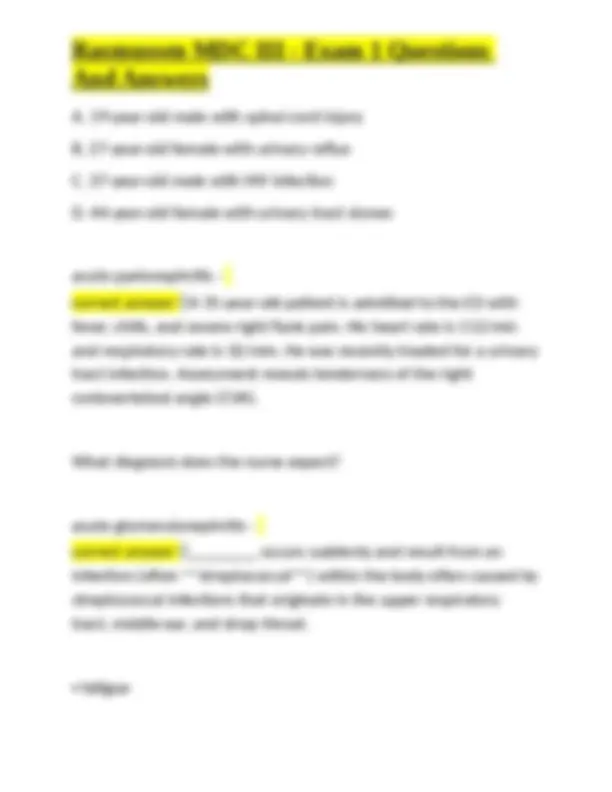
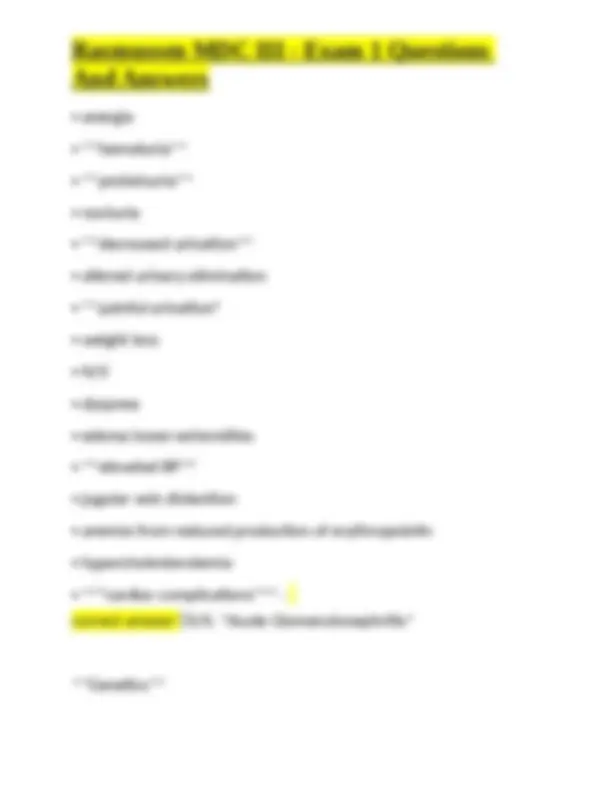
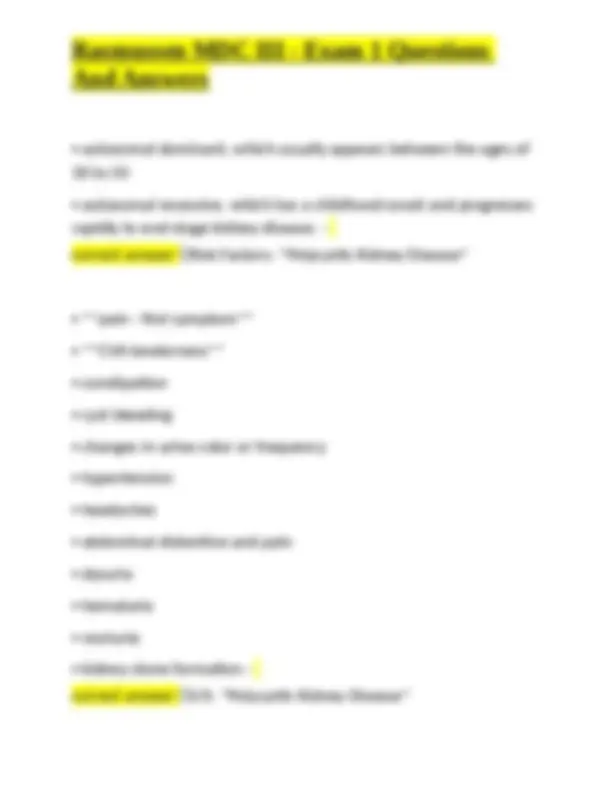
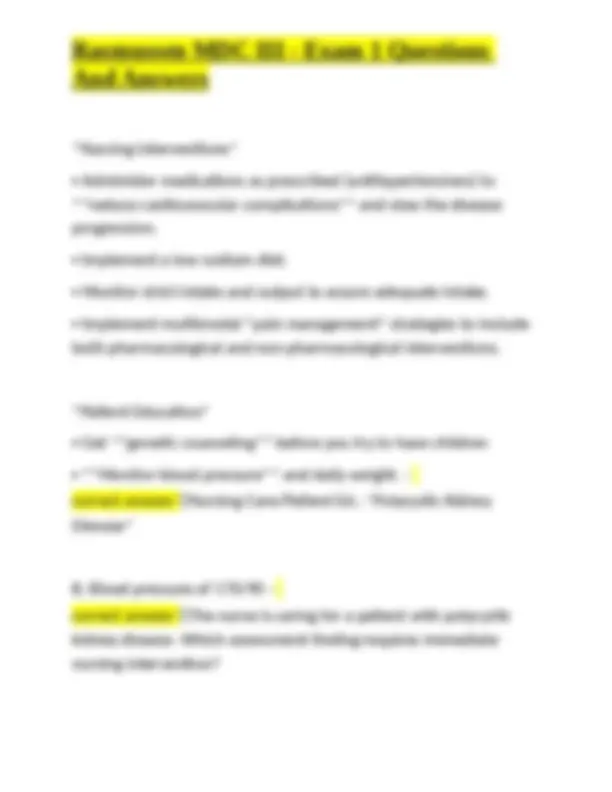
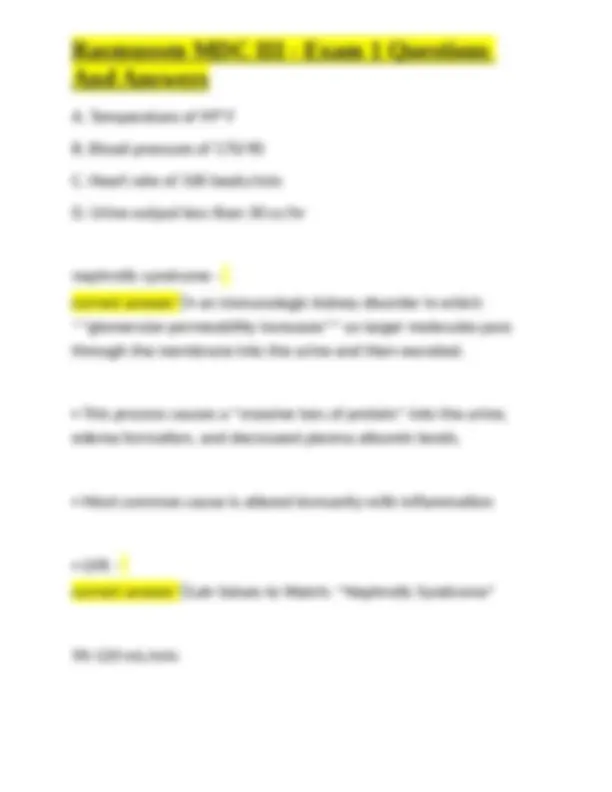
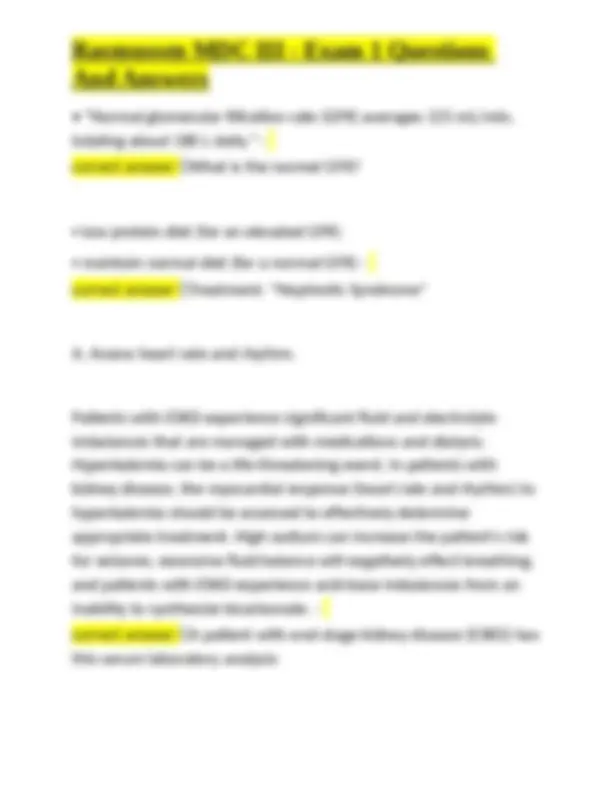
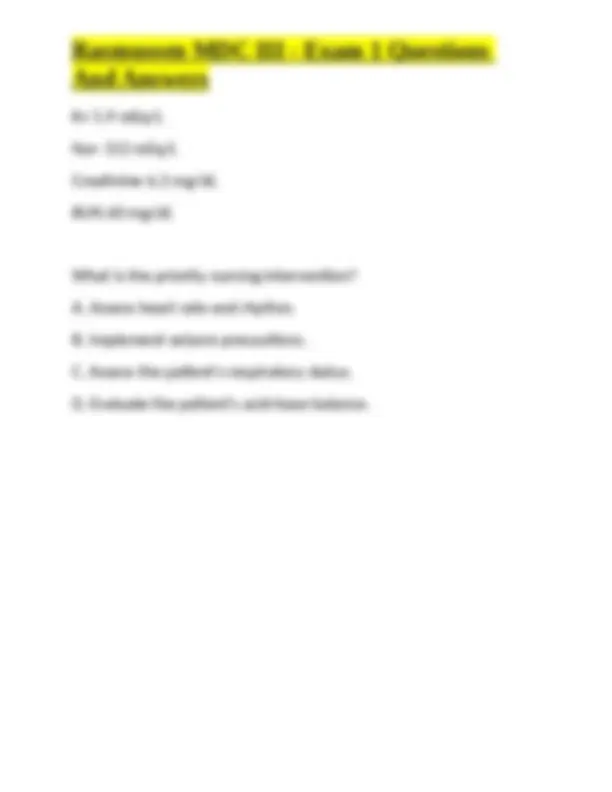


Study with the several resources on Docsity

Earn points by helping other students or get them with a premium plan


Prepare for your exams
Study with the several resources on Docsity

Earn points to download
Earn points by helping other students or get them with a premium plan
Community
Ask the community for help and clear up your study doubts
Discover the best universities in your country according to Docsity users
Free resources
Download our free guides on studying techniques, anxiety management strategies, and thesis advice from Docsity tutors
Rasmussen MDC III - Exam 1 Questions And Answers
Typology: Exams
1 / 24

This page cannot be seen from the preview
Don't miss anything!

















▪ chancre ▪ fever ▪ headache ▪ muscle aches ▪ rash Late: ▪ organ failure ▪ blindness ▪ neuro changes - correct answer ✅S/S: Syphilis C. Syphilis - correct answer ✅A 20-year-old sexually active male reports symptoms of a low-grade fever, headache, malaise, muscular aches, sore throat, and a rash on his hands and feet. What condition does the nurse anticipate? A. HIV B. HPV
C. Syphilis D. Gonorrhea Primary syphilis - correct answer ✅Which stage of syphilis is this? ▪ Ulcer called chancre develop at the site of entry and can occur anywhere. ▪ Highly infectious stage, begins as a small papule, then breaks down to a painless, indurated, smooth weeping lesion Secondary syphilis - correct answer ✅Which stage of syphilis is this? ▪ Develops 6 weeks to 6 months, becomes systemic circulating in the blood. ▪ Commonly mistaken for the flu. Rash appears on the palmar surfaces of hands and feet. Patchy alopecia ▪ Penicillin G
▪ hormone levels ▪ low blood pressure S/S: ▪ dizziness ▪ weakness ▪ fatigue ▪ SOB - correct answer ✅Patient has heavy vaginal bleeding - What are you checking and what manifestations do you expect? ▪ Kegel exercises ▪ Bladder training ▪ No drinking after 5pm or 6pm ▪ Avoid foods or drinks with caffeine ▪ Skin care ▪ Proper hygiene - correct answer ✅Patient Education: Urinary Incontinence
▪ distended bladder ▪ visible mass above the symphysis pubis ▪ difficulty initiating urination ▪ decreased urine stream ▪ diminished force of urinary stream ▪ urinary hesitancy ▪ urinary frequency ▪ urinary urgency ▪ urinary retention ▪ incontinence ▪ incomplete emptying of the bladder ▪ dribbling post-voiding ▪ nocturia ▪ hematuria ▪ straining with urination ▪ obstruction of urine flow presents as a uniform, elastic non-tender enlargement - correct answer ✅S/S: BPH
▪ Chemotherapy ▪ Alcohol and drug abuse ▪ Trauma or surgery to the pelvic area ▪ Lumbosacral injuries ▪ Pelvic fractures ▪ Neurological diseases (Parkinson's and multiple sclerosis) ▪ Inflammation of seminal vesicles, urethra, and prostate ▪ Prostatectomy, TURP ▪ Poor overall health that prevents sexual intercourse ▪ DVT, PE ▪ Cardiac issues - correct answer ✅Risk factors for ED ▪ respect to privacy ▪ nonjudgmental ▪ open ended Qs "Tell me more..."
"It sounds like..." - correct answer ✅Therapeutic communication... bone - correct answer ✅Prostate Cancer - Where is the most common site for metastasis? Phosphorus (>4.5) Potassium (> 5.0) Magnesium (> 2.5) Calcium (>10.5) Creatinine (> 1.2) BUN (> 20) Liver enzymes - correct answer ✅Blood levels that might be elevated if prostate CA has metastasized to the bone (SATA?) ▪ PSA
Modifiable ▪ Lack of exercise ▪ Diet ▪ Alcohol consumption ▪ Obesity ▪ Lack of breastfeeding ▪ Breast implants ▪ Smoking ▪ Medications such as birth control and hormone therapy ▪ No pregnancies (nulliparity) - correct answer ✅Risk Factors: Breast CA mammogram -> breast biopsy - correct answer ✅If a patient comes in and found a breast lump, what is the process after that? self-examination mammograms - start at age 45 - correct answer ✅Screening: Breast CA
total hysterectomy - correct answer ✅Treatment: Endometrial (Uterine) CA ▪ respiratory depression ▪ check drains ▪ pain management ▪ DVT/PE - given heparin/lovenox ▪ infection ▪ bleeding ▪ check for urinary retention ▪ mobilize the patient ▪ pulmonary hygiene - correct answer ✅Post-surgical care (ex: hysterectomy) B. Heavy vaginal bleeding with clots - correct answer ✅A client returns from surgery after a laparoscopic total abdominal hysterectomy. On initial assessment, which finding by the nurse requires immediate intervention?
cervical ablation - correct answer ✅Treatment for Cervical Cancer FOR AT LEAST 4 WEEKS ▪ Refraining from sexual intercourse for 2-3 days after the procedure. ▪ Do not use tampons or douche. ▪ Do not take tub baths. ▪ Avoid heavy lifting. ▪ Report vaginal bleeding, foul-smelling drainage, or fever. ▪ Bed rest - correct answer ✅Post-cervical ablation care ▪ medications ▪ drugs/alcohol ▪ infarct of kidney, liver, heart ▪ anything that causes decrease in perfusion (dehydration, hypovolemia, shock, cardiac) ▪ Decreased blood flow
▪ Damage to the kidneys by disease processes ▪ Blockage of the urinary tract - correct answer ✅Causes: Acute Kidney Injury ▪ dialysis (severe) - ESRD, CKD ▪ treat the underlying cause ▪ fluid replacement for hypovolemia ▪ fluid restriction in low urine output ▪ hemodialysis ▪ diuretics ▪ Kayexalate 30 g - loose BMs is a successful treatment ▪ monitor I&Os and daily weights. - correct answer ✅Treatment: Acute Kidney Injury
▪ signs of bleeding ▪ check fistula for thrill and bruit ▪ sterile technique with dressing changes ▪ port site clean with dialysis catheter - correct answer ✅Nursing Care: Dialysis ▪ no blood pressure on that side ▪ no blood draws on that side ▪ no IV medications on that side ▪ put on a limb alert bracelet - correct answer ✅Patient Education: Fistula D. Check for a bruit and thrill by auscultation and palpation over the site. - correct answer ✅A 70-year-old woman with chronic kidney disease and a history of type 2 diabetes had surgery two weeks ago to place a vascular graft access for hemodialysis. Which precaution will the nurse follow to ensure the function of the AV graft? A. Insert an IV and run saline at 10 mL/hr. B. Keep the patient's arm elevated on two pillows.
C. Monitor blood pressure and radial pulses in both arms. D. Check for a bruit and thrill by auscultation and palpation over the site. ▪ flank pain ▪ fever ▪ N/V ▪ difficulty urinating ▪ elevated WBC - correct answer ✅S/S: Urolithiasis and Pyelonephritis ▪ pyelonephritis is the result of repeated upper UTIs in patients with anatomy abnormalities of the urinary tract ▪ imaging, like a CT scan - correct answer ✅Since the s/s of urolithiasis and pyelonephritis are so similar, how you diagnose the difference? B. 27-year-old female with urinary reflux - correct answer ✅The nurse is caring for four patients. Which patient does the nurse identify as at highest risk for acute pyelonephritis?
▪ anergia ▪ hematuria ▪ proteinuria ▪ nocturia ▪ decreased urination ▪ altered urinary elimination ▪ *painful urination ▪ weight loss ▪ N/V ▪ dyspnea ▪ edema lower extremities ▪ elevated BP ▪ jugular vein distention ▪ anemia from reduced production of erythropoietin ▪ hypercholesterolemia ▪ "cardiac complications" - correct answer ✅S/S: Acute Glomerulonephritis Genetics
▪ autosomal dominant, which usually appears between the ages of 30 to 50 ▪ autosomal recessive, which has a childhood onset and progresses rapidly to end-stage kidney disease. - correct answer ✅Risk Factors: Polycystic Kidney Disease ▪ pain - first symptom ▪ CVA tenderness ▪ constipation ▪ cyst bleeding ▪ changes in urine color or frequency ▪ hypertension ▪ headaches ▪ abdominal distention and pain ▪ dysuria ▪ hematuria ▪ nocturia ▪ kidney stone formation - correct answer ✅S/S: Polycystic Kidney Disease